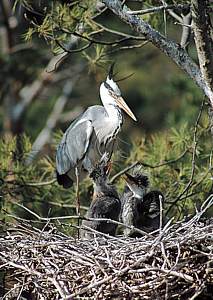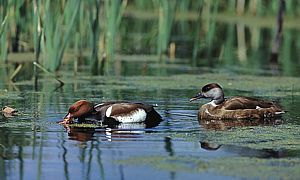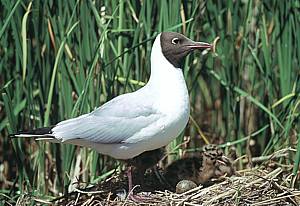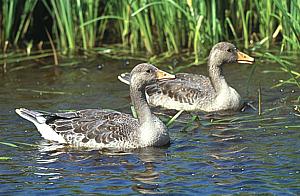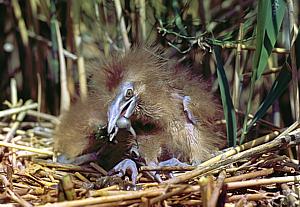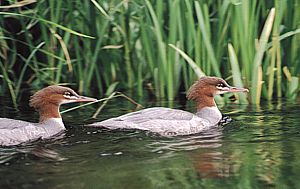|
BIRDS
|
|||||||||||||||
Text:
|
Aquatic birds
There are 42 lakes, 6 greater rivers and innumerable quantity of small ponds and wet grounds in the area of Wigry National Park. It creates profitable conditions of occurrence of many species of water birds where most of them have their breeding season here. The lakes of Wigry, Pierty, Białe or Omułówek, abounding with fish, are a rich alimentary base for such birds as: cormorants, herons, grebes, gulls and terns. The coastal belt of rushes assures a safe nest place to bitterns, coots, reed warblers, sedge-warblers, water rails and common moorhens. The mid-forest lakes are often visited by golden-eyes, mallards, tufted ducks, garganeys, red-crested pochards, scaups and goosanders.
Red-crested pochard Netta rufina belongs to the duck-like family. Its body is about 50 cm long, the length of wing is 24-28 cm, the weight of body varies from 0, 8 to 1, 5 kg. In the mating period - the plumage of the male is red, black, white and bronze - with the occiput feathers forming an elongated crest. The female's color is more modest - it is brown-grey and it does not have a crest. It lives in the greater lakes and ponds. It mainly eats water plants and small animals, but in small quantities. In search for food it dives or grounds. The nest is built on the piles of old reeds, more seldom on the shore. In April the female lays 6-10 of eggs and she carefully looks after the offspring. The young learn to fly after 8 weeks. It flies to Poland in March and flies away in August-November. It spends the winter period in the Mediterranean countries and in the south of Asia.
Black-headed gull Larus ridibundus is the most numerous representative of the gull family in Poland. Its body is about 40 cm long, the length of wing is 28-30 cm, the weight of body varies from 200 to 300 g. Male and female are of the same color - during the mating period the head is brown and black, the rest is white and grey, but for the black endings of wings. Legs and beak are red. Later on the head becomes white with a grey spot in the vicinity of aural covers. Young gulls ' plumage is spotted brown. They live on the inland waters; when the breeding season is over they live on the seas. Periodically they bivouac on the fields, finding the food together with the herds of rooks and jackdaws. In winter they willingly spend their time in greater cities. They hunt for small animals, mostly insects and small fishes. They have their nests in the colonies of tens to several thousand pairs. Their nests are built on the sandy bank or on the floating islets of water vegetation. In the first of May the female lays 2-3 eggs, which are then incubated by both parents. The young attain the ability of flight in the 6 week of life. This type of gull flies in March-April and flies away in August-September. It spends the winter period in the western and southern Europe and in Asia.
Greylag goose Anser anser belongs to the duck family. Its body is about 80 cm long, the length of wing is 39-49 cm, the weight of body varies from 2500 to 6000 g. The male is a little bit larger than the female, the grey and brown plumage with white stripes is characteristic of the male and female. The beak is orange and legs are pink. It is a gregarious species. It lives in the ponds, lakes and old rivers with fully developed vegetation. It is a herbivorous animal, finding its food both in water and on land, too. The male unites with the female for a lifetime. Their nests are built in the inaccessible places; on peat bogs, swamps etc. At the turn of March and April the female lays 6-9 of eggs which are incubated by her for about 30 days. Both parents look after their offspring. The young are able to fly after 56 days from being hatched, however they are ready for their first water expedition after 2 days. Greylag goose flies to us in February-April and flies away in September or October. It spends the winter period in the western Europe and in the southern and western Asia. It is a fleeting species in the Park area. It is a wild ancestor of the household goose which became domesticated in Egypt about 2200 years B.C. It is of a species to be hunted.
Grey heron Ardea cinerea Grey heron Ardea cinerea belongs to the family of herons. Its body is about 90 cm long, the length of wing varies from 42, 5 to 48 cm, the weight of body reaches 1000-1900 g. Just like all other herons the grey heron bends its neck during the flight in the shape of letter S, thanks to which it is easy to be distinguished from other birds. The plumage is grey and the head and neck are white. It has long yellow legs and a strong beak. As opposed to other birds herons do not look after their feathers with the help of a secretion of the rump gland due to its atrophy. Instead of this they use the powder (microscopic horn scales produced in the so-called powder pillows on the chest and underbelly). This powder makes the plumage look characteristically blue. Heron lives in colonies; and it builds its nests on the trees, mostly pines, oaks and alders, not always in the immediate vicinity of water.
The trees, on which herons have their nests, wither after some time later under the influence of corrosive excrements of these birds. Herons mostly eat fishes; additionally they catch small mammalians, amphibians, reptiles, snails and insects. At the beginning of April the female lays 4-5 of eggs, which are incubated by both partners. The young leave the nest after 7 weeks from being hatched. Heron flies to us at the end of March and flies away in October.
Goosander Mergus merganser belongs to the groups of goosanders. Its body is 60-80 cm long, the length of wing varies from 25 to 30 cm, the weight reaches 1100-2000 g. The male is considerably greater than the female. Both male and female have got a characteristic crest on the head consisting of dark feathers. It lives in the mountainous and wooded areas with stagnant and flowing waters and sea-coasts of the Baltic Sea. It flies quickly straight ahead with the extended neck. It mostly eats fishes and small water animals. They catch their trophy diving up to 4 m deep, using their long, hooked and crooked at the end beaks. The nest in most cases is situated in a hole on a high tree (up to a dozen or so meters) over the ground; sometimes it build nests in a burrow or a wind-broken tree. It willingly uses the breeding boxes which are hung out by the Park. The breeding season starts at the end of April and at that time the female lays 7-15 of eggs which are incubated just by her for about 30 days. The nestlings spend up to 1-2 days in the nest after being hatched; after that they jump out of the nest and they wander over water with their mother to learn to swim and to dive. Tired nestlings rest on the back of mother. When the breeding season is over, Mergus merganser groups into bigger herds consisting of up to several hundreds individuals. It is a wandering species. It flies to us in March or April and flies away in October - December. It spends the winter period on the Baltic Sea, the North Sea, the Atlantic Ocean, the Mediterranean and the Caspian Sea.
|
||||||||||||||
|
|
|
